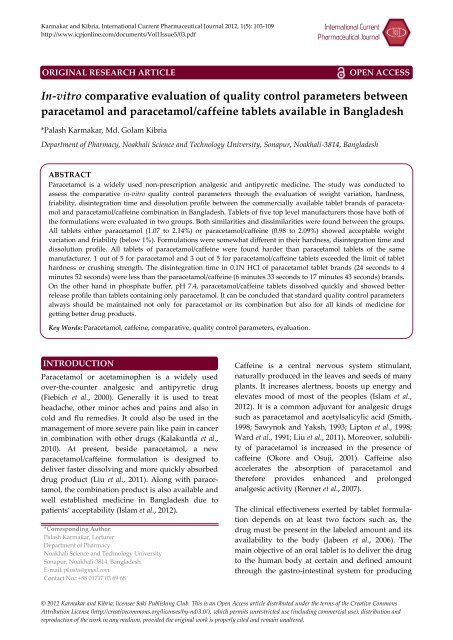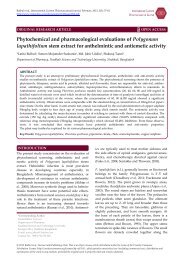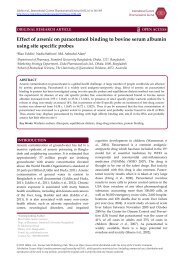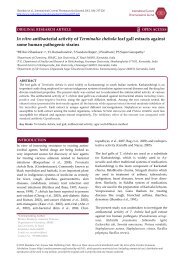In-vitro comparative evaluation of quality control parameters ...
In-vitro comparative evaluation of quality control parameters ...
In-vitro comparative evaluation of quality control parameters ...
Create successful ePaper yourself
Turn your PDF publications into a flip-book with our unique Google optimized e-Paper software.
Karmakar and Kibria, <strong>In</strong>ternational Current Pharmaceutical Journal 2012, 1(5): 103-109<br />
http://www.icpjonline.com/documents/Vol1Issue5/03.pdf<br />
<strong>In</strong>-<strong>vitro</strong> <strong>comparative</strong> <strong>evaluation</strong> <strong>of</strong> <strong>quality</strong> <strong>control</strong> <strong>parameters</strong> between<br />
paracetamol and paracetamol/caffeine tablets available in Bangladesh<br />
*Palash Karmakar, Md. Golam Kibria<br />
Department <strong>of</strong> Pharmacy, Noakhali Science and Technology University, Sonapur, Noakhali-3814, Bangladesh<br />
INTRODUCTION<br />
Paracetamol or acetaminophen is a widely used<br />
over-the-counter analgesic and antipyretic drug<br />
(Fiebich et al., 2000). Generally it is used to treat<br />
headache, other minor aches and pains and also in<br />
cold and flu remedies. It could also be used in the<br />
management <strong>of</strong> more severe pain like pain in cancer<br />
in combination with other drugs (Kalakuntla et al.,<br />
2010). At present, beside paracetamol, a new<br />
paracetamol/caffeine formulation is designed to<br />
deliver faster dissolving and more quickly absorbed<br />
drug product (Liu et al., 2011). Along with paracetamol,<br />
the combination product is also available and<br />
well established medicine in Bangladesh due to<br />
patients’ acceptability (Islam et al., 2012).<br />
<strong>In</strong>ternational Current<br />
Pharmaceutical Journal<br />
ORIGINAL RESEARCH ARTICLE OPEN ACCESS<br />
ABSTRACT<br />
Paracetamol is a widely used non-prescription analgesic and antipyretic medicine. The study was conducted to<br />
assess the <strong>comparative</strong> in-<strong>vitro</strong> <strong>quality</strong> <strong>control</strong> <strong>parameters</strong> through the <strong>evaluation</strong> <strong>of</strong> weight variation, hardness,<br />
friability, disintegration time and dissolution pr<strong>of</strong>ile between the commercially available tablet brands <strong>of</strong> paracetamol<br />
and paracetamol/caffeine combination in Bangladesh. Tablets <strong>of</strong> five top level manufacturers those have both <strong>of</strong><br />
the formulations were evaluated in two groups. Both similarities and dissimilarities were found between the groups.<br />
All tablets either paracetamol (1.07 to 2.14%) or paracetamol/caffeine (0.98 to 2.09%) showed acceptable weight<br />
variation and friability (below 1%). Formulations were somewhat different in their hardness, disintegration time and<br />
dissolution pr<strong>of</strong>ile. All tablets <strong>of</strong> paracetamol/caffeine were found harder than paracetamol tablets <strong>of</strong> the same<br />
manufacturer. 1 out <strong>of</strong> 5 for paracetamol and 3 out <strong>of</strong> 5 for paracetamol/caffeine tablets exceeded the limit <strong>of</strong> tablet<br />
hardness or crushing strength. The disintegration time in 0.1N HCl <strong>of</strong> paracetamol tablet brands (24 seconds to 4<br />
minutes 52 seconds) were less than the paracetamol/caffeine (6 minutes 33 seconds to 17 minutes 43 seconds) brands.<br />
On the other hand in phosphate buffer, pH 7.4, paracetamol/caffeine tablets dissolved quickly and showed better<br />
release pr<strong>of</strong>ile than tablets containing only paracetamol. It can be concluded that standard <strong>quality</strong> <strong>control</strong> <strong>parameters</strong><br />
always should be maintained not only for paracetamol or its combination but also for all kinds <strong>of</strong> medicine for<br />
getting better drug products.<br />
Key Words: Paracetamol, caffeine, <strong>comparative</strong>, <strong>quality</strong> <strong>control</strong> <strong>parameters</strong>, <strong>evaluation</strong>.<br />
*Corresponding Author:<br />
Palash Karmakar, Lecturer<br />
Department <strong>of</strong> Pharmacy<br />
Noakhali Science and Technology University<br />
Sonapur, Noakhali-3814, Bangladesh<br />
E-mail: pknstu@gmail.com<br />
Contact No.: +88 01717 03 69 68<br />
Caffeine is a central nervous system stimulant,<br />
naturally produced in the leaves and seeds <strong>of</strong> many<br />
plants. It increases alertness, boosts up energy and<br />
elevates mood <strong>of</strong> most <strong>of</strong> the peoples (Islam et al.,<br />
2012). It is a common adjuvant for analgesic drugs<br />
such as paracetamol and acetylsalicylic acid (Smith,<br />
1998; Sawynok and Yaksh, 1993; Lipton et al., 1998;<br />
Ward et al., 1991; Liu et al., 2011). Moreover, solubility<br />
<strong>of</strong> paracetamol is increased in the presence <strong>of</strong><br />
caffeine (Okore and Osuji, 2001). Caffeine also<br />
accelerates the absorption <strong>of</strong> paracetamol and<br />
therefore provides enhanced and prolonged<br />
analgesic activity (Renner et al., 2007).<br />
The clinical effectiveness exerted by tablet formulation<br />
depends on at least two factors such as, the<br />
drug must be present in the labeled amount and its<br />
availability to the body (Jabeen et al., 2006). The<br />
main objective <strong>of</strong> an oral tablet is to deliver the drug<br />
to the human body at certain and defined amount<br />
through the gastro-intestinal system for producing<br />
© 2012 Karmakar and Kibria; licensee Saki Publishing Club. This is an Open Access article distributed under the terms <strong>of</strong> the Creative Commons<br />
Attribution License (http://creativecommons.org/licenses/by-nd/3.0/), which permits unrestricted use (including commercial use), distribution and<br />
reproduction <strong>of</strong> the work in any medium, provided the original work is properly cited and remain unaltered.
Table 1: Evaluation <strong>of</strong> different <strong>quality</strong> <strong>control</strong> <strong>parameters</strong><br />
<strong>of</strong> paracetamol and paracetamol/caffeine tablets.<br />
Sample<br />
(Tablet<br />
brands)<br />
Weight<br />
variation<br />
(%)<br />
Hardness<br />
(kgf)<br />
Friability<br />
(%)<br />
Disintegration<br />
time (sec/min)<br />
A1 (P) 1.21 5.15 0.34 36 sec<br />
A2 (P/C) 0.98 6.91 0.09 6 min 33 sec<br />
B1 (P) 1.07 4.31 0.31 24 sec<br />
B2 (P/C) 1.47 5.99 0.15 10 min 7 sec<br />
C1 (P) 2.03 6.98 0.27 2 min 53 sec<br />
C2 (P/C) 1.33 8.26 0.34 14 min 13 sec<br />
D1 (P) 2.14 9.17 0.21 39 sec<br />
D2 (P/C) 1.79 11.55 0.16 9 min 5 sec<br />
E1 (P) 1.81 6.19 0.64 4 min 52 sec<br />
E2 (P/C) 2.09 11.23 0.11 17 min 43 sec<br />
A1, B1, C1, D1, E1= Tablet brands <strong>of</strong> paracetamol alone<br />
A2, B2, C2, D2, E2= Tablet brands <strong>of</strong> paracetamol/caffeine combination<br />
P = Paracetamol; P/C = Paracetamol and caffeine combination<br />
Kgf = Kilogram <strong>of</strong> force; sec = Second; min = Minute<br />
increasing tablet weight for combination formulation<br />
(Tousey, 2004).<br />
<strong>In</strong> the friability test, all brands showed impressive<br />
friability values. The friability values for paracetamol<br />
tablet brands were ranged from 0.21 to 0.64%<br />
whereas the paracetamol/caffeine tablet brands<br />
showed 0.09 to 0.34% <strong>of</strong> friability. <strong>In</strong> all formulations<br />
the percent (%) friability was less than 1%<br />
which ensures that all the tablets <strong>of</strong> each brand <strong>of</strong><br />
both formulations were mechanically stable (Kalakuntla<br />
et al., 2010).<br />
The disintegration time <strong>of</strong> all tablet brands <strong>of</strong><br />
paracetamol A1, B1, C1, D1 and E1 was satisfactory<br />
as uncoated USP tablets have disintegration time<br />
standards as low as 5 minutes (Banker and Anderson,<br />
2009). Whereas tablets <strong>of</strong> paracetamol/caffeine<br />
A2, B2, C2, D2 and E2 showed higher disintegration<br />
time though they also meet the maximum limit <strong>of</strong> 30<br />
minutes (Banker and Anderson, 2009).The overall<br />
disintegration time for paracetamol tablet brands<br />
was in the ranged from 24 seconds to 4 minutes 52<br />
seconds while paracetamol/caffeine tablet brands<br />
ranged from 6 minutes 33 seconds to 17 minutes 43<br />
seconds. So the disintegration time for paracetamol/caffeine<br />
tablet brands is much higher than the<br />
paracetamol tablet brands. The results obtained in<br />
the study showed that the hardness or breaking<br />
strength <strong>of</strong> the tablets directly relates with the<br />
disintegration time, i.e. more hardness <strong>of</strong> paraceta-<br />
Table 2: Evaluation <strong>of</strong> dissolution pr<strong>of</strong>ile <strong>of</strong> paracetamol<br />
and paracetamol/caffeine tablets.<br />
Sample<br />
(Tablet brands)<br />
(%) Drug<br />
release after<br />
10 min<br />
(%) Drug<br />
release after<br />
20 min<br />
(%) Drug<br />
release after<br />
30 min<br />
A1 (P) 49.78 88.08 103.57<br />
A2 (P/C) 55.03 92.17 101.06<br />
B1 (P) 51.19 91.41 99.92<br />
B2 (P/C) 57.11 94.13 105.02<br />
C1 (P) 40.51 76.37 94.11<br />
C2 (P/C) 43.97 83.03 99.36<br />
D1 (P) 38.92 69.42 96.5<br />
D2 (P/C) 46.39 76.92 98.15<br />
E1 (P) 43.19 79.71 95.41<br />
E2 (P/C) 45.92 84.04 101.21<br />
A1, B1, C1, D1, E1= Tablet brands <strong>of</strong> paracetamol alone<br />
A2, B2, C2, D2, E2= Tablet brands <strong>of</strong> paracetamol/caffeine combination<br />
P = Paracetamol; P/C = Paracetamol and caffeine combination<br />
min = Minute<br />
mol/caffeine tablets increased their disintegration<br />
time than the tablets <strong>of</strong> paracetamol (Ahmed et al.,<br />
1998). Results <strong>of</strong> weight variation, hardness,<br />
friability and disintegration tests are shown in<br />
Table 1.<br />
Dissolution was another studied important <strong>quality</strong><br />
<strong>control</strong> <strong>parameters</strong> directly related to the absorption<br />
and bioavailability <strong>of</strong> drug (Pabla et al., 2009). The<br />
study revealed that at different time intervals drug<br />
release rate was better in paracetamol/caffeine tablet<br />
brands comparing with the paracetamol alone. After<br />
10 minutes, the release rate <strong>of</strong> tablet brands <strong>of</strong><br />
paracetamol was 38.92 to 51.19% whereas release<br />
rate <strong>of</strong> paracetamol/caffeine tablets was 43.97 to<br />
57.11% which showed that initial release rate <strong>of</strong><br />
paracetamol/caffeine combination was more than<br />
paracetamol alone and this also continued after 20<br />
minutes. Finally after 30 minutes, 99-100% drug<br />
release was observed in A1 and B1 for paracetamol<br />
brands and A2, B2, C2 and E2 for paracetamol/caffeine<br />
brands. All other brands <strong>of</strong> both<br />
groups also showed more than 90 % drug release<br />
after 30 minutes. The better dissolution pr<strong>of</strong>ile <strong>of</strong><br />
paracetamol/caffeine might be the impact <strong>of</strong><br />
caffeine, as the solubility <strong>of</strong> paracetamol is accelerated<br />
by caffeine (Okore and Osuji, 2001). Outcome<br />
<strong>of</strong> the test has been shown in Table 2 and Figure 1.<br />
106
(a)<br />
(c)<br />
(e)<br />
Figure 1: Dissolution pr<strong>of</strong>ile <strong>of</strong> different brands a) A1 and A2, b) B1 and B2, c) C1 and C2, d) D1 and D2, e) E1 and E2.<br />
A1, B1, C1, D1, E1= Tablet brands <strong>of</strong> paracetamol alone<br />
A2, B2, C2, D2, E2= Tablet brands <strong>of</strong> paracetamol/caffeine combination<br />
(b)<br />
(d)<br />
107
CONCLUSION<br />
Paracetamol is a well established and proven<br />
analgesic and antipyretic drug. The current pharma<br />
market <strong>of</strong> Bangladesh is flooded with various<br />
combination preparations. With other combination<br />
formulation, paracetamol/caffeine is also now<br />
widely used for the management <strong>of</strong> different pain in<br />
the country. Therapeutic response <strong>of</strong> any formulation<br />
depends on its <strong>quality</strong> <strong>parameters</strong>. From the<br />
study it was identified that weight variation and<br />
friability test <strong>of</strong> both paracetamol and paracetamol/caffeine<br />
tablet brands complied the<br />
specification. Variation was obtained in hardness,<br />
disintegration time and dissolution pr<strong>of</strong>ile during<br />
the test procedure. Paracetamol/caffeine tablets<br />
were found harder than tablets having only paracetamol<br />
and the combination brands also increased<br />
the time <strong>of</strong> disintegration. It should be strictly<br />
considered that an ideal tablet will have sufficient<br />
hardness to maintain its mechanical stability but not<br />
more. Because harder tablet can delay disintegration<br />
time or alter dissolution pr<strong>of</strong>ile. On the other hand,<br />
paracetamol/caffeine tablet brands showed better<br />
disintegration pr<strong>of</strong>ile than the single paracetamol<br />
brands. At every interval drug release rate was<br />
more in paracetamol/caffeine tablets than paracetamol<br />
alone. This might be resulted by the presence <strong>of</strong><br />
caffeine in the formulation as it increased the<br />
solubility <strong>of</strong> paracetamol followed by dissolution<br />
pr<strong>of</strong>ile. Finally, as <strong>quality</strong> <strong>control</strong> <strong>parameters</strong> are<br />
related to one another from initial step to pharmacological<br />
action <strong>of</strong> the drug, a high-<strong>quality</strong> tablet<br />
either single or in combination should meet all the<br />
standard <strong>quality</strong> parameter for getting its desired<br />
therapeutic response.<br />
ACKNOWLEDGEMENT<br />
The authors are thankful to Dr. Mohammad Salim<br />
Hossain, Chairman, Department <strong>of</strong> Pharmacy,<br />
Noakhali Science and Technology University for<br />
providing the laboratory facilities to perform the<br />
research work.<br />
REFERENCES<br />
REFERENCES<br />
Ahmed, A., Ali, S.A., Hassan, F., Ayub, S., Haque, N. (1998).<br />
Effect <strong>of</strong> disintegrants and hardness on the disintegration<br />
time <strong>of</strong> acetaminophen tablets. Pakistan Journal <strong>of</strong> Pharmaceutical<br />
Sciences, 11(1): 41-46. PMid:16414810<br />
Aw<strong>of</strong>isayo, S.O., Aw<strong>of</strong>isayo, O.A., Eyen, N., Udoh, I.E.<br />
(2010). Comparative assessment <strong>of</strong> the <strong>quality</strong> <strong>control</strong><br />
measurements <strong>of</strong> multisource <strong>of</strong>loxacin tablets marketed<br />
in Nigeria. Dissolution technologies, 17(2): 20-25.<br />
Banker, G.S. and Anderson, N.R. (2009). Tablets. <strong>In</strong> Lachman,<br />
L. and Lieberman, H.A, The theory and practice <strong>of</strong> industrial<br />
pharmacy (Special <strong>In</strong>dian ed., pp 229-345), CBS<br />
Publishers and Distributors Pvt. Ltd., <strong>In</strong>dia .<br />
British Pharmacopoeia. (2005): Volume. 4, Appendix XII H<br />
A273, Table: 2.9.5-1.<br />
Fiebich, B.L., Lieb, K., Hull, M., Aicher, B., Ryn, J.V., Pairet,<br />
M., Engelhardt, G. (2000). Effects <strong>of</strong> caffeine and paracetamol<br />
alone or in combination with acetylsalicylic acid on<br />
prostaglandin E2 synthesis in rat microglial cells. Neuropharmacology,<br />
39(11): 2205-2213. DOI<br />
Gangwar, S., Singh, S., Garg, G., Garg, V., Sharma, P.K.<br />
(2010). To compare the disintegrating property <strong>of</strong> papaya<br />
starch and sago starch in paracetamol tablets. <strong>In</strong>t J Pharmacy<br />
Pharm Sci, 2(Suppl 2): 148-151.<br />
Gupta, A.k.(1994).Tablet. <strong>In</strong>troduction to pharmaceutics-I<br />
(3rd ed., pp 239-274), CBS Publishers and Distributors,<br />
<strong>In</strong>dia.<br />
Islam, S.M.A., Islam, S., Shahriar, M., Dewan , I. (2011).<br />
Comparative in <strong>vitro</strong> dissolution study <strong>of</strong> acecl<strong>of</strong>enac<br />
marketed tablets in two different dissolution media by<br />
validated analytical method. Journal <strong>of</strong> Applied Pharmaceutical<br />
Science, 1(9): 87-92.<br />
Islam, S.M.A., Shultana, S., Sayeed, M.S.B., Dewan, I. (2012).<br />
UV-Spectrophotometric and RP-HPLC methods for the<br />
simultaneous estimation <strong>of</strong> acetaminophen and caffeine:<br />
validation, comparison and application for marketed tablet<br />
analysis. <strong>In</strong>t J Pharm, 2(1): 39-45.<br />
Jabeen, S., Ali, A., Hassan, F., Fatima, N. (2006). Studies on<br />
the effects <strong>of</strong> cyclodextrin polymer as a tableting aid on<br />
some selected analgesics. Pakistan Journal <strong>of</strong> Pharmacology,<br />
23(1): 67-71.<br />
Jain, N., Mandal, S., Banweer, J., Jain, S. (2012). Effect <strong>of</strong><br />
superdisintegrants on formulation <strong>of</strong> taste masked fast<br />
disintegrating cipr<strong>of</strong>loxacin tablets. <strong>In</strong>ternational Current<br />
Pharmaceutical Journal, 1(4): 62-67. DOI<br />
Kalakuntla, R., Veerlapati, U., Chepuri, M., Raparla, R. (2010).<br />
Effect <strong>of</strong> various super disintegrants on hardness, disintegration<br />
and dissolution <strong>of</strong> drug from dosage form. J. Adv.<br />
Sci. Res, 1(1): 15-19.<br />
Kishore, B.H., Venkareswararao, T., Sankar, K.R., Rao, B.S.<br />
(2011). Studies on dissolution rate <strong>of</strong> paracetamol tablets<br />
by using different polymers. Journal <strong>of</strong> Global Trends in<br />
Pharmaceutical Sciences, 2(1): 1-10.<br />
Lipton, R.B., Stewart, W.F., Ryan, R.E. Jr., Saper, J., Silberstein,<br />
S. (1998). Efficacy and safety <strong>of</strong> acetaminophen,<br />
aspirin, and caffeine in alleviating migraine headache<br />
pain: three double-blind, randomized, placebo-<strong>control</strong>led<br />
trials. Arch Neural, 55: 210-217. DOI PMid:9482363<br />
108
Liu, D.J., Kotler, M., Sharples, S. (2011). Pharmacokinetic and<br />
bioequivalence study evaluating a new paracetamol/caffeine<br />
formulation in healthy human volunteers.<br />
Journal <strong>of</strong> Bioequivalence & Bioavailability, 3(11): 251-257.<br />
Musa, H., Sule, Y.Z., Gwarzo, M.S. (2011). Assessment <strong>of</strong><br />
physicochemical properties <strong>of</strong> metronidazole tablets<br />
marketed in Zaria, Nigeria. <strong>In</strong>t J Pharm Pharm Sci, 3(Suppl<br />
3): 27-29.<br />
Nijhu, R.S., Akhter, D.T., Jhanker, Y.M. (2011). Development<br />
and validation <strong>of</strong> UV spectrophotometric method for<br />
quantitative estimation <strong>of</strong> nitroglycerin in pharmaceutical<br />
dosage form. <strong>In</strong>ternational Current Pharmaceutical Journal,<br />
1(1): 1-5. DOI<br />
Ofori-Kwakye, K., Osei-Yeboah, F., Kipo, S.L. (2010).<br />
Formulation and <strong>quality</strong> <strong>evaluation</strong> <strong>of</strong> two conventional<br />
release tablet formulations. <strong>In</strong>ternational Journal <strong>of</strong> Pharmaceutical<br />
Sciences Review and Research, 4(1): 94-99.<br />
Okore, V.C., Osuji, A.C. (2001). A model study on caffeine -<br />
paracetamol interactions. Acta Pharm, 51: 139-145.<br />
Pabla, D., Akhlaghi, F., Zia, H. (2009). A <strong>comparative</strong> pHdissolution<br />
pr<strong>of</strong>ile study <strong>of</strong> selected commercial levothyroxine<br />
products using inductively coupled plasma mass<br />
spectrometry. European Journal <strong>of</strong> Pharmaceutics and<br />
Biopharmaceutics, 72: 105–110. DOI PMid:18996189<br />
Rawlins, E.A. (1977). Bentley’s text book <strong>of</strong> pharmaceutics<br />
(8th ed., pp. 289-290), Bailliere Tindal publisher.<br />
Renner, B., Clarke, G., Grattan, T., Beisel, A., Mueller, C.,<br />
Werner, U., Kobal, G., Brune, K. (2007). Caffeine accelerates<br />
absorption and enhances the analgesic effect <strong>of</strong><br />
acetaminophen. J Clin Pharmacol, 47(6): 715-726. DOI<br />
PMid:17442681<br />
Sawynok, J., Yaksh, T.L. (1993). Caffeine as an analgesic<br />
adjuvant: a review <strong>of</strong> pharmacology and mechanisms <strong>of</strong><br />
action. Pharmacol. Rev., 45(1): 43-85. PMid:8475169<br />
Smith, R. (1998). Migraine relief with acetaminophen, aspirin,<br />
and caffeine: abstract and commentary. JAMA, 279: 1310.<br />
DOI<br />
Tousey, M.D. (2004). Preventing and fixing weight and<br />
hardness defects: Strategies for production personnel.<br />
Tablet press operation. Available at:<br />
www.dipharma.com/Tousey_904TC.pdf [Accesses on:<br />
08.03.2012]<br />
Tousey, M.D. (2011). Tablet pro: A tablet making training<br />
resource for tablet making pr<strong>of</strong>essionals. Techceuticals,<br />
4(1):1-15. www.dipharma.com/TP_V4.pdf [Accesses on:<br />
09.03.2012]<br />
Ward, N., Whitney, C., Avery, D., Dunner, D. (1991). The<br />
analgesic effects <strong>of</strong> caffeine in headache. Pain, 44: 151-155.<br />
DOI<br />
109









